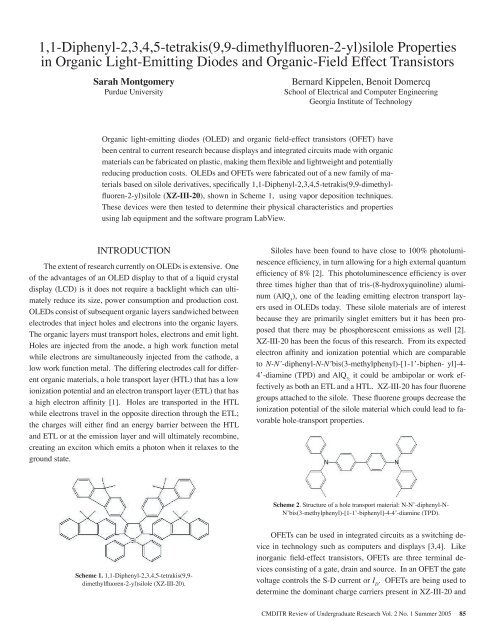Student Project Abstracts 2005 - Pluto - University of Washington
Student Project Abstracts 2005 - Pluto - University of Washington
Student Project Abstracts 2005 - Pluto - University of Washington
You also want an ePaper? Increase the reach of your titles
YUMPU automatically turns print PDFs into web optimized ePapers that Google loves.
1,1-Diphenyl-2,3,4,5-tetrakis(9,9-dimethylfluoren-2-yl)silole Propertiesin Organic Light-Emitting Diodes and Organic-Field Effect TransistorsSarah MontgomeryPurdue <strong>University</strong>Bernard Kippelen, Benoit DomercqSchool <strong>of</strong> Electrical and Computer EngineeringGeorgia Institute <strong>of</strong> TechnologyOrganic light-emitting diodes (OLED) and organic field-effect transistors (OFET) havebeen central to current research because displays and integrated circuits made with organicmaterials can be fabricated on plastic, making them flexible and lightweight and potentiallyreducing production costs. OLEDs and OFETs were fabricated out <strong>of</strong> a new family <strong>of</strong> materialsbased on silole derivatives, specifically 1,1-Diphenyl-2,3,4,5-tetrakis(9,9-dimethylfluoren-2-yl)silole(XZ-III-20), shown in Scheme 1, using vapor deposition techniques.These devices were then tested to determine their physical characteristics and propertiesusing lab equipment and the s<strong>of</strong>tware program LabView.INTRODUCTIONThe extent <strong>of</strong> research currently on OLEDs is extensive. One<strong>of</strong> the advantages <strong>of</strong> an OLED display to that <strong>of</strong> a liquid crystaldisplay (LCD) is it does not require a backlight which can ultimatelyreduce its size, power consumption and production cost.OLEDs consist <strong>of</strong> subsequent organic layers sandwiched betweenelectrodes that inject holes and electrons into the organic layers.The organic layers must transport holes, electrons and emit light.Holes are injected from the anode, a high work function metalwhile electrons are simultaneously injected from the cathode, alow work function metal. The differing electrodes call for differentorganic materials, a hole transport layer (HTL) that has a lowionization potential and an electron transport layer (ETL) that hasa high electron affinity [1]. Holes are transported in the HTLwhile electrons travel in the opposite direction through the ETL;the charges will either find an energy barrier between the HTLand ETL or at the emission layer and will ultimately recombine,creating an exciton which emits a photon when it relaxes to theground state.Siloles have been found to have close to 100% photoluminescenceefficiency, in turn allowing for a high external quantumefficiency <strong>of</strong> 8% [2]. This photoluminescence efficiency is overthree times higher than that <strong>of</strong> tris-(8-hydroxyquinoline) aluminum(AlQ 3), one <strong>of</strong> the leading emitting electron transport layersused in OLEDs today. These silole materials are <strong>of</strong> interestbecause they are primarily singlet emitters but it has been proposedthat there may be phosphorescent emissions as well [2].XZ-III-20 has been the focus <strong>of</strong> this research. From its expectedelectron affinity and ionization potential which are comparableto N-N’-diphenyl-N-N’bis(3-methylphenyl)-[1-1’-biphen- yl]-4-4’-diamine (TPD) and AlQ 3;it could be ambipolar or work effectivelyas both an ETL and a HTL. XZ-III-20 has four fluorenegroups attached to the silole. These fluorene groups decrease theionization potential <strong>of</strong> the silole material which could lead to favorablehole-transport properties.Scheme 2. Structure <strong>of</strong> a hole transport material: N-N’-diphenyl-N-N’bis(3-methylphenyl)-[1-1’-biphenyl]-4-4’-diamine (TPD).Scheme 1. 1,1-Diphenyl-2,3,4,5-tetrakis(9,9-dimethylfluoren-2-yl)silole (XZ-III-20).OFETs can be used in integrated circuits as a switching devicein technology such as computers and displays [3,4]. Likeinorganic field-effect transistors, OFETs are three terminal devicesconsisting <strong>of</strong> a gate, drain and source. In an OFET the gatevoltage controls the S-D current or I D. OFETs are being used todetermine the dominant charge carriers present in XZ-III-20 andCMDITR Review <strong>of</strong> Undergraduate Research Vol. 2 No. 1 Summer <strong>2005</strong> 85




